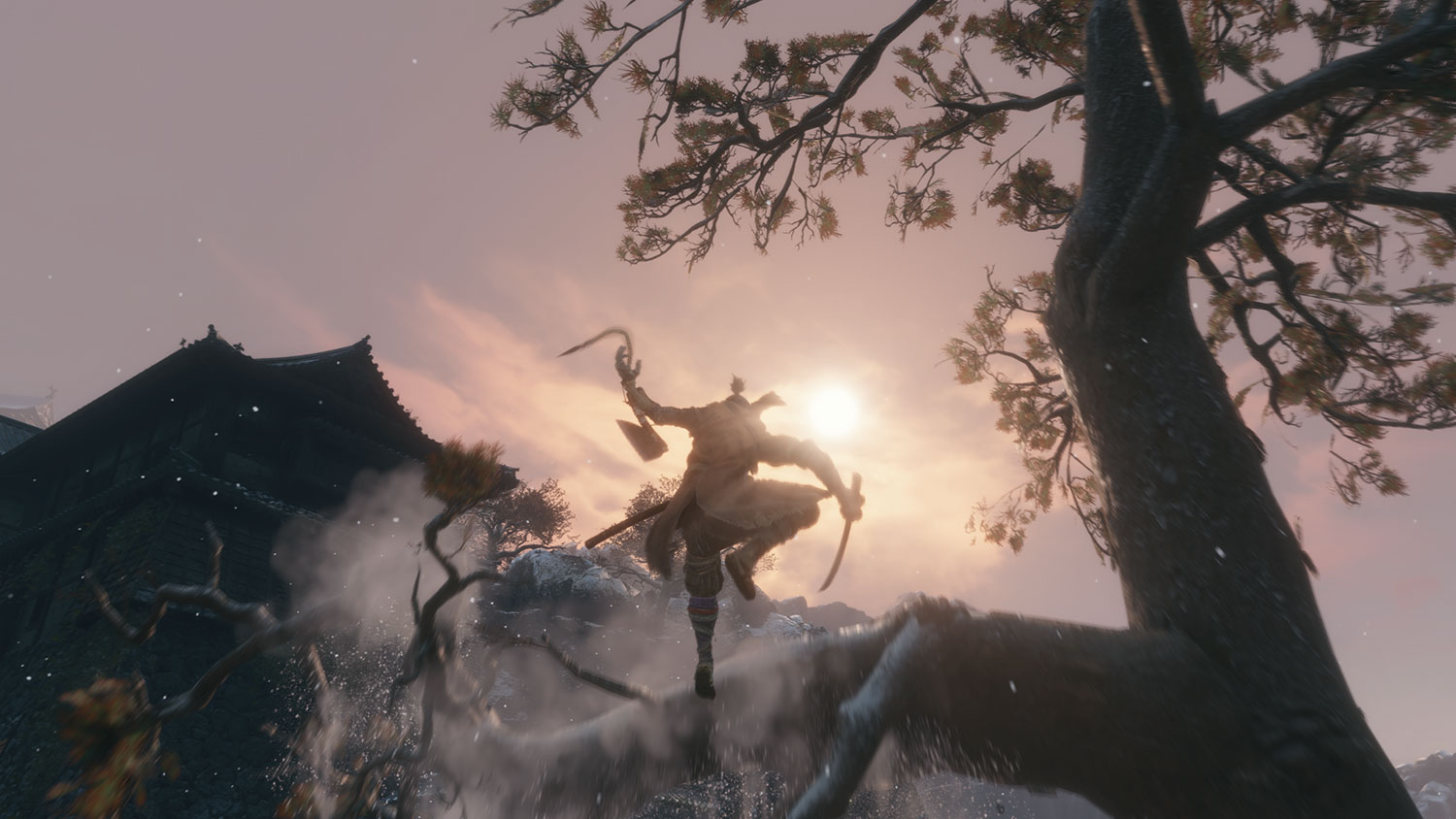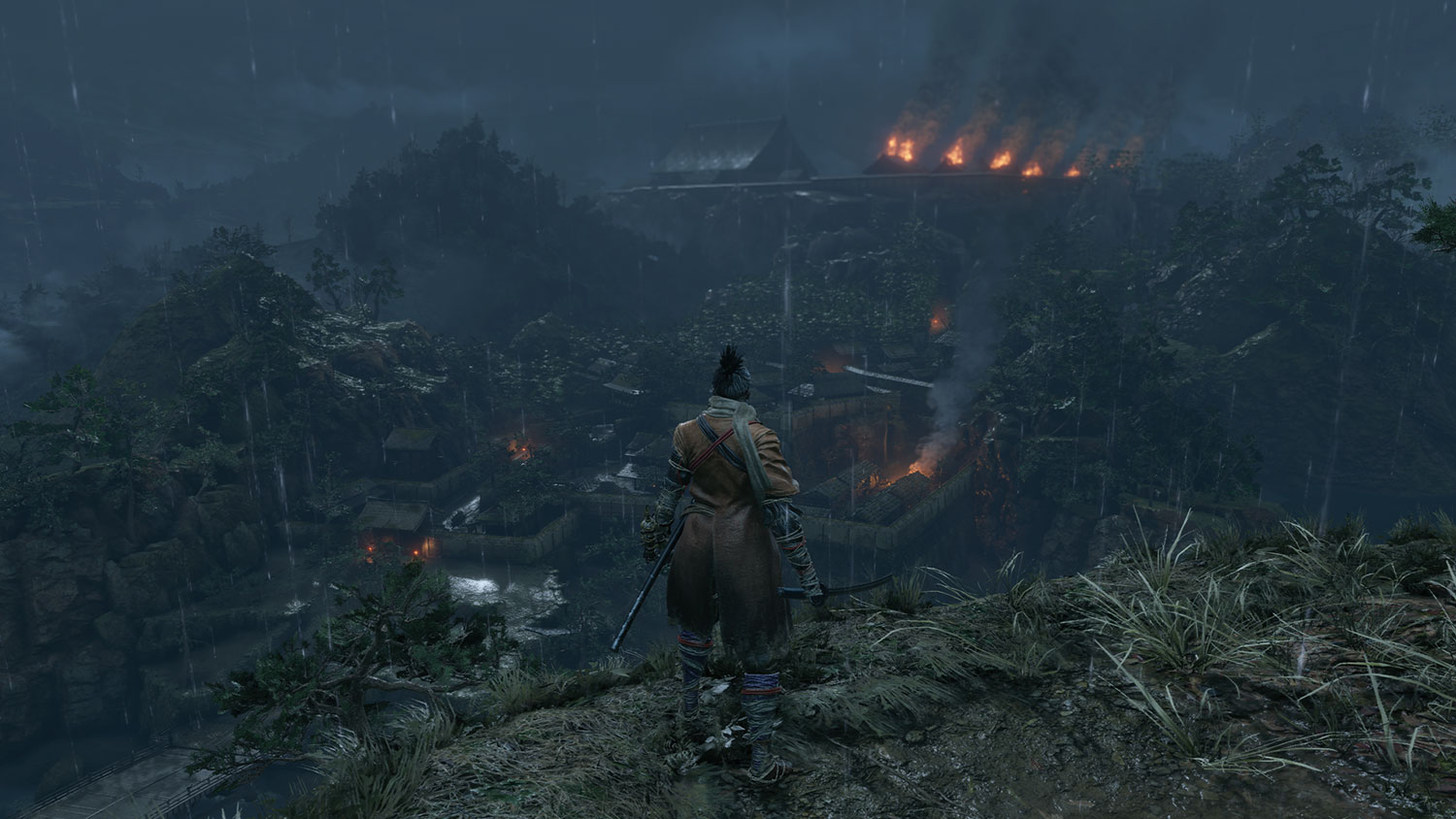After 6 Hours With Sekiro: Shadows Die Twice, I'm Loving Every Brutal Minute
I have taken a 6 hour plunge into Sekiro: Shadows Die Twice and it’s hard not to love every second even though I’m dying hardcore.

Imagine you're minding your own shinobi business, protecting your Lord, as you do, and some samurai jerkface cuts off your arm. That's basically how Sekiro: Shadows Die Twice starts, and it's been pretty much downhill from there for me.
I've fallen off of cliffs, been crushed by ogres, brutally stabbed, came back to life and then stabbed again. But every time I returned to the living, I learned something that gave me a chance in my new life. It's almost like the horror version of Groundhog Day. And I love every minute of it.
For those that are unfamiliar, Sekiro: Shadows Die Twice is a painfully difficult third-person action adventure game that takes place in 16th century Sengoku period Japan. It’s developed by FromSoftware, the same people who are responsible for Dark Souls. I’ve played only 6 hours so far, so I can’t give a fair score to it just yet, but damn is this game amazing.
Fresh Take On Storytelling
If you’ve played the SoulsBorne series, then you are well aware that the method of storytelling that is presented through those games are slightly unorthodox. Everything is obscure and requires further reading to fully understand, but Sekiro is the complete opposite. That’s not to say that there’s no room for interpretation, but the storytelling is much more direct.

In fact, there's probably more direct storytelling in the intro of Sekiro than there is in all of Dark Souls combined. The reason why FromSoftware decided to spice it up this time around is because there’s an actual main character (Sekiro), as opposed to the usual hollowing corpse that comes back to life for no reason.
This game revolves around a shinobi named Sekiro, the one-armed wolf, who is hunting down the leader of the Ashina clan in order to rescue his kidnapped lord and avenge the arm that was literally stripped from him. It’s kind of like Taken if it was set in 16th century Japan.
There's more direct storytelling in the intro of Sekiro than there is in all of Dark Souls combined.
Going in, I wasn’t sure how FromSoftware would handle this kind of direct approach, but the company did an excellent job at maintaining its knack for storytelling in this new format. I actually prefer this style, as it makes me care more about the character I’m playing and the characters that I interact with around me.
Sign up to get the BEST of Tom's Guide direct to your inbox.
Get instant access to breaking news, the hottest reviews, great deals and helpful tips.
MORE: Sekiro Is More Than Just Samurai Dark Souls
After playing SoulsBorne for so long, it felt really weird to hear your own character’s voice and have a personality exist beyond your own. To add on to that, the English dub is surprisingly good. Sekiro’s voice is badass and everyone else’s felt really authentic. For reference, the game is actually defaulted to Japanese, but as someone who prefers their anime dubbed as well, I went with English. Sue me.
Immersive World Design
While Sekiro’s world design isn’t nearly as out there as the Souls series, it’s incredibly impressive. Where Dark Souls is limited by the horizontal plane, Sekiro opens up vertical gameplay through the use of a grappling hook, making it feel remarkably less linear than its spiritual predecessors.

There are wide open areas with multiple routes you can take to get to your objective, and even areas that you can skip completely. As I journeyed through the Hirata Estate, I stood atop a pagoda and gazed below at the building and shines; the detail put into the Japanese architecture convinced me that people actually live in this world.
Sekiro opens up vertical gameplay through the use of a grappling hook, making it feel remarkably less linear than its spiritual predecessors.
Of course, Sekiro isn’t taken over completely by realism. There are plenty of monstrous beings throughout the game that will certainly trigger some kind of phobia. The most frustrating enemy I’ve fought was a giant samurai that spit poison at me. It’s not exactly visually terrifying, but I assure you that I am emotional scarred.

Complementing FromSoftware’s immersive world is Sekiro’s excellent sound design and musical score. The fast paced violins and drums intertwining with clanging swords and sharp slices makes each battle ridiculously intense, if it wasn't already.
While it’s not a feature in any of FromSoftware’s other games, it would have been nice to see a little photo mode action in this game, considering how beautiful it looks. (And because I want a more convenient way to take screenshots).
The One-Armed Wolf
If FromSoftware has taught me anything, it’s to get used to death, even if you can technically “Die Twice.” For those that are unaware, Sekiro’s biggest gimmick is that you revive yourself just after you die. I know many SoulsBorne players have expressed concern about the game being too easy this way, but I can assure you, it’s not.

Equipped with a katana and the use of your Shinobi tools, your goal during combat is to break the enemy’s posture (a gauge depicted within their health bar) while maintaining your own. Once their posture is broken, you can go in for the execution. Some enemies have really high posture, so it’s better just to gnaw away at their health slowly instead of attacking full force.
The game gives you a ton of free movement to build your own fighting style.
Posture is the replacement for stamina in this game, and you use it to guard and deflect attacks. If your posture breaks, you’re essentially defenseless and the enemy can mortally wound you. But on the upside, you can sprint, attack, jump and dodge infinitely without a pesky stamina bar weighing you down.
MORE: The 17 Best Hard Games for the Masochists Among Us
I haven’t gotten the hang of deflecting and dodging enemy attacks yet, so there’s still a lot of getting good in my future, but the combat is so in-depth, and the game gives you a ton of free movement to build your own fighting style. Not to mention that you can straight up stealth kill fools.
Beyond the base combat, a key feature to your arsenal are your Prosthetic Tools. You find items around the world and attach them to your prosthetic in order to give you some sort of edge in battle. For example, Loaded Shuriken is a low damage but useful long range attack and Loaded Axe is a short ranged attack capable of breaking wooden shields. I really enjoy the Zelda-esque nature of the tools and how it makes the combat that much more dynamic.

Instead of a traditional leveling system where you progressively increase your stats, you get skill points that you can use to learn new moves like Whirlwind Slash, which is exactly what it sounds like, and even gain abilities like Suppress Presence, which increases your stealth. This leaves more room for growth and recognition that your character is evolving, as opposed to continuously guessing if that one level in Dexterity is actually doing anything for your damage.
Despite that, FromSoftware hasn’t taken stat increases completely off of the table. Throughout the game you are able to upgrade two stats: Vitality and Attack Power. To increase Vitality, you have to use Prayer Beads, which I found on named enemies with two health bars. And for Attack Power, you need to use something called Memory, which I haven’t come across yet. When I upgraded my health, the chunk that it gave me was definitely noticeable, so it felt really rewarding after I leveled it up.
MORE: 19 Games We Can't Wait to Play in 2019
When you die, the game punishes you by making all of the non-player characters sick, which is really concerning. I’m not sure if they can actually die themselves, yet, but their affliction impacts how much Unseen Aid you get. So when you die, there’s a chance (Unseen Aid percentage) the game will take half of your experience and money from you. Unlike in Dark Souls, you can’t simply grab your souls (currency) from where you died. Instead, Sekiro relies on this percentage based system that I still haven’t fully wrapped my head around yet.
Overall, this game tosses a ton of RPG nonsense found in the Souls series completely out of the window and replaces it with insane, action oriented features. And you know what? I think the game is infinitely better for it.
Bottom Line
Dare I say, this may turn out to be the best game that FromSoftware has ever developed. I am only 6 hours in, but every moment and every scene is so intense and captivating. I could have never imagined anything like this coming out of a traditional Souls game. But before I lay down the final score, I’ll need a couple thousand more deaths under my belt. Stay tuned for the full review, coming at you whenever my average lifespan exceeds past two minutes.
Credit: FromSoftware

